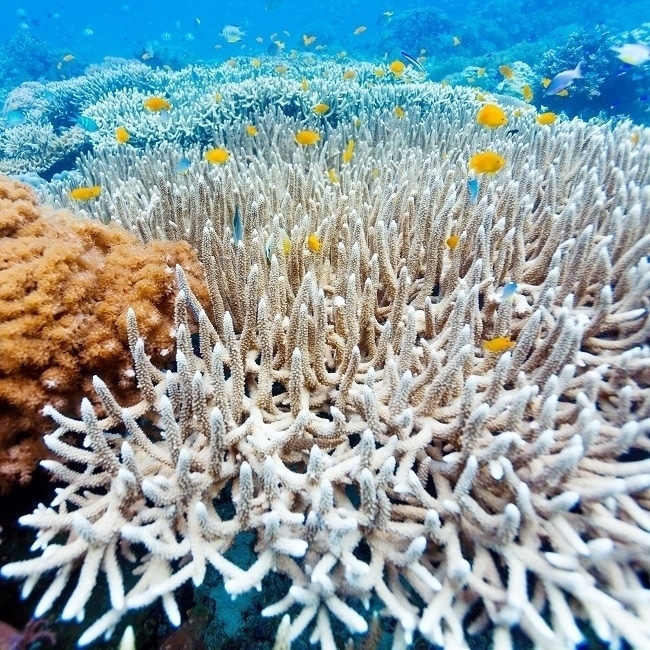Mar 25 2016
Stanford scientists have discussed a way of dealing with neutralizing human activities that turn oceans acidic: blowing tiny bubbles. Blowing bubbles, they say, removes carbon dioxide (CO2) off coastal marine areas and transports it to the atmosphere, protecting coral reefs and oyster farms.
 Image Credit: Rostislav Ageev/Shutterstock.com
Image Credit: Rostislav Ageev/Shutterstock.com
As much as 30 to 60% of all the coral reefs have died thanks to the Industrial revolution, transferring CO2 to the ocean waters, turning them more acidic, and harming, in particular, marine organisms such as oysters, mussels and corals that utilize calcium carbonates to assemble their shells and skeletons. Blowing tiny bubbles, outlined in a study in the online publication of the journal of Environmental Science & Technology, could provide an inexpensive solution.
Ocean acidification is particularly troublesome for coral reefs because the entire structure of the ecosystems is built upon the calcium carbonate skeletal remains of dead coral. Ocean acidification makes it difficult for corals to calcify and makes it easier to erode these skeletal remains, threatening the integrity of the entire reef.
David Koweek, Doctoral Candidate, Stanford's School of Earth, Energy & Environmental Sciences
There are several benefits derived from a healthy coral reef. It is home to many marine organisms, and provides dietary supplies to island subsistence communities. Financially, as much as $30 billion could be the annual benefit from it. It guards low-lying coastal areas from flooding during wild storms and high tides.
Koweek and his coauthors demonstrated that the transfer rate of CO2 between the air and the ocean could be enhanced by up to 30 times faster than natural processes, by bubbling air through seawater for several hours in the early morning. This process considerably reduced the greenhouse gas concentrations in the local marine patches.
The nice thing about the bubble pulse method is that it provides an engineering technique that can help bring us closer to conditions that coral reefs were used to 100 years ago, and to which they've been adapted for many thousands of years.
Rob Dunbar, W.M. Keck Professor of Earth Science, Stanford
An idea bubbles up
While exploring the natural chemical cycles of shallow-water ecosystems, including coral reefs, Koweek observed that the levels of CO2 in these environments rise and fall in the same predictable way throughout the day. During the day, the coral and other photosynthesizing marine organisms absorb the gas, resulting in reduced CO2 levels. The CO2 levels rise in the evenings when these organisms respire. This phenomenon gave way to the idea of using bubbles to reduce localized ocean acidity.
By using air bubbles to remove CO2 from the sea water in the predawn hours - when the ocean is acidic - and transfer it to the atmosphere, would it help to spur coral growth? This was the question that Koweek started his analysis with. If there were a lower concentration of the gas in the bubbles than the surrounding water, then that would naturally diffuse the gas.
At Stanford's Hopkins Marine Station, the researchers carried out a bubbling experiment in a water tank that was fitted with sensors. Every night, the tank was filled with large amounts of giant kelp, which continued to respire all through the night, while adding CO2 to the water, and simulating the accumulation of CO2. This CO2 buildup occurs due to respiration in the coastal ecosystems during the night time. The researchers would then arrive the next morning, take off the kelp, and would start to bubble the seawater containing high levels of CO2 to test how bubbling reduces the concentration of CO2. It was observed that just two hours of bubble-mediated ventilation considerably increased the transfer of CO2 from the ocean into the atmosphere by as much as 10 to 30 times.
From tank to tides
A computer model developed by the team confirmed the results obtained from the water tank experiment, and the scientists did gain confidence in the accuracy of their model. Performed at the right time, bubble stripping of the gas could remove extreme acidity of coastal systems now and in the future.
The present level of rise in CO2 poses a great threat to marine organisms, and the ocean acidifications are already evident in tide pools across California, as revealed in a recent study done by researchers at the Carnegie Department of Global Ecology at Stanford.
According to Koweek, the ecological, cultural and economic benefits outweigh the relatively small amount of CO2 in the atmosphere produced by the bubbling process, and by the compressors utilized for producing the bubbles, as the operations could be quite small.
If this idea takes off, you could imagine people running these compressors on solar power. In the tropics, where there's a lot of sunlight, you could charge your compressors with solar energy during the day and then bubble at night.
David Koweek, Doctoral Candidate, Stanford's School of Earth, Energy & Environmental Sciences
If carried out strategically, a little bubbling could go a long way.
Many Pacific coral reef terraces have a mostly unidirectional water flow. If you operate your bubbler in an area that is upstream of a large section of coral, you could reduce CO2 levels for an entire reef.
Rob Dunbar, W.M. Keck Professor of Earth Science, Stanford
Bubble stripping could ultimately help in protecting more than just coral.
Many coastal ecosystems, including salt marshes, seagrass meadows, and mangroves undergo daily variations in CO2 due to photosynthesis during daylight hours and respiration during nighttime hours.
David Koweek, Doctoral Candidate, Stanford's School of Earth, Energy & Environmental Sciences
David Mucciarone, a science lab manager at Stanford, is the co-author of the study.
The National Science Foundation and a McGee/Levorsen research grant from the Stanford School of Earth, Energy & Environmental Sciences funded the research work.